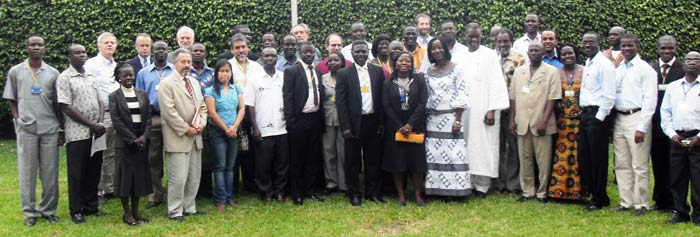A cross-continental coalition on cassava for Africa
- Monday, 26 July 2010 07:56
Download E-publication
The cassava Challenge Initiative of the Generation Challenge Programme (GCP) of the Consultative Group on International Agricultural Research (CGIAR) was launched on 23rd July 2010 in Accra, Ghana, in a two-day meeting that continued to 24th July. Through this Challenge Initiative (CI), GCP aims to improve cassava yields in Africa, with a primary focus on drought tolerance, but also taking into account other important aspects such as pest and disease tolerance, nutritional enhancement, and appeal to farmers and markets. The meeting opened with a keynote address from Hon Sherry Ayitey, Ghana’s Minister for Environment Science and Technology. It was hosted by Ghana’s Crops Research Institute (CRI) of the Council for Scientific and Industrial Research (CSIR).
 In her address launching the CI, Hon Ayitey (pictured) observed that cassava is a major staple in sub-Saharan Africa, supporting some 600m people, and providing their carbohydrates. It is therefore important to fortify cassava against the ravages of drought, disease and pests, and to enhance its nutritional content. And although cassava is also an industrial crop used in the manufacture of starches, biofuels and pharmaceuticals, as well as for animal feed, it is first and foremost important for food security, cultivated by 80 percent of Ghana’s farmers, and accounting for more than one fifth (22 percent) of the country’s agricultural GDP.
In her address launching the CI, Hon Ayitey (pictured) observed that cassava is a major staple in sub-Saharan Africa, supporting some 600m people, and providing their carbohydrates. It is therefore important to fortify cassava against the ravages of drought, disease and pests, and to enhance its nutritional content. And although cassava is also an industrial crop used in the manufacture of starches, biofuels and pharmaceuticals, as well as for animal feed, it is first and foremost important for food security, cultivated by 80 percent of Ghana’s farmers, and accounting for more than one fifth (22 percent) of the country’s agricultural GDP.
More science needed
“For farmers in Africa today, productivity is low and poverty is high because too little science has been brought into farming,” noted Hon Ayittey. “The government recognises the pivotal role biotechnology and research can play in economic growth and poverty reduction.” She explained that it is for this reason that her ministry recently forwarded the Biosafety Bill to parliament for approval, to ensure security and exchange of information among researchers.
 The welcome address was given by Dr Abdulai B Salifu, Director General of CSIR (pictured). “Cassava is a crop dear to Ghana. The quality of protein in cassava leaves, which are consumed as vegetables in some regions, is equal to the protein in eggs.” Dr Salifu quoted extensively from Cassava Song, an ode by the late Nigerian writer Flora Nwapa, where she praises cassava as a mother and nurturer.
The welcome address was given by Dr Abdulai B Salifu, Director General of CSIR (pictured). “Cassava is a crop dear to Ghana. The quality of protein in cassava leaves, which are consumed as vegetables in some regions, is equal to the protein in eggs.” Dr Salifu quoted extensively from Cassava Song, an ode by the late Nigerian writer Flora Nwapa, where she praises cassava as a mother and nurturer.
Dr Salifu noted that food production must double by 2050 to feed a rising population. This emphasises the importance of the work by GCP and the CGIAR in improving crops to adapt to climate change and different environments. He said he was particularly looking forward to seeing GCP’s Integrated Breeding Platform (IBP) contribute to providing the Ghanaian cassava entrepreneurs with clean planting materials to boost production. Dr Salifu also underscored the importance of taking into account information from ongoing cassava projects in Ghana. These include the West African Agricultural Productivity Programme (WAAPP) and Cassava Adding Value for Africa (CAVA) implemented by CSIR, and the Roots and Tubers Improvement Programme (RTIMP) implemented by the Ministry of Food and Agriculture.
He observed that the 14 improved varieties disseminated to Ghanaian farmers since 1993 are insufficient in meeting the growing demand for improved varieties to satisfy emerging needs and markets. He said this calls for urgent intervention by stakeholders to mitigate the factors limiting production in order to realise the full potential and benefit from cassava.
Dr Salifu emphasised the importance of drought research: “Although cassava has the reputation of being a drought-tolerant crop, when deprived of water, plant and root development are affected.”
|
Participants at the launch of the cassava Challenge Initiative. |
Banking on a proven winner
Nature has indeed endowed cassava with a drought defence that surpasses most other crops, but that does not by any means suggest that cassava is immune to drought.
“During drought, you will not get the same level of failure as for other crops like cereals where there can be total failure,” said Dr Elizabeth Acheampong of the University of Ghana. “In harsh situations, farmers do not have the choice of any other crop, and the choice is between growing cassava, or growing nothing. But even for cassava, drought reduces production, which is what makes research on improving production under drought so important.”
With its natural resilience during drought, cassava is clearly ahead of the pack when it comes to surviving drought.
 Delving beyond drought
Delving beyond drought
“Cassava is a crop for Africa. One that we know, one that has proven itself, and one that knows Africa, where cassava means hope: with cassava, returns are guaranteed,” said Dr Emmanuel Okogbenin (pictured) of Nigeria’s National Root Crops and Tubers Research Institute (NRCRI), who is also the Product Delivery Coordinator of the cassava CI, as well as Coordinator of the cassava Community of Practice (CoP) that brings together breeders from Africa (see link below Collective action to boost cassava yields in Africa).
But surviving drought alone is not enough: cassava may survive drought but succumb to pests or disease. Therefore, beyond drought, much more remains to be done to safeguard cassava from these threats, maximise returns and also to get the most out of the crop by enhancing its nutritional content.
Connections for better breeding
On capacity development, besides individual fellowships (see link below Breeders in formation: Nurturing a new generation of African cassava breeders), the cassava CoP has benefitted from GCP’s Genotyping Support Service which targets crop research institutes, and from the Capacity building à la carte programme, which provides tailor-made support to applied research teams. GCP has contributed to establishing marker-assisted selection (MAS) laboratories in Ghana, Nigeria, Uganda and Tanzania, as well as elite germplasm from previous GCP-funded cassava projects.
The CoP also benefitted from good material from CIAT and IITA in breeding for pest and disease resistance, and is also now partnering with the CGIAR HarvestPlus Challenge Program in a project on high-protein beta-carotene-rich cassava.
| “Switching to SNPs from the labour-intensive SSRs that are currently in use for cassava will greatly reduce the cost of generating data, and increase the genotyping throughput to the level necessary for a full integration of molecular breeding into cassava breeding programmes,” noted Xavier Delannay who leads GCP’s Integrated Breeding Theme. |
In Phase II, the CoP is looking to the IBP to provide an adequate number of single nucleotide polymorphisms (SNPs) to improve cassava breeding in detecting quantitative trait loci (QTLs) when drawing on various sources of germplasm to maximise the diversity and genetic gains of potential crosses. “Cassava is highly heterozygous and segregates from seed,” says Dr Okogbenin. “So, in a bid not to lose desired traits, cassava breeding yields a mixed cocktail of the good, the bad and the ugly!”
In response to this need for molecular breeding approaches to strengthen cassava breeding, GCP will fund the conversion of up to 1,500 cassava SNPs to a breeding-friendly genotyping system made available to cassava breeders as part of the marker services of the IBP.
“So far, we have identified 784 SNPs spread throughout the cassava genome, favouring those that are polymorphic in the parents of a mapping population designed to map drought tolerance loci,” said Dr Pablo Rabinowicz of the University of Maryland’s Institute for Genome Sciences (USA). Of these, 384 SNPs are available for download from the project website, while the other 384 SNPs are expected shortly. This effort is funded by GCP.
Missing links
There are vital missing links in cassava’s productivity value chain resulting in weak markets that leave farmers at the mercy of volatile supply–demand dynamics. As such, peak production during harvest time is – paradoxically – a low moment, with the market glut depressing prices and demoralising farmers. There is need for market analysis as grounds for policy reform to stabilise the cassava market in Africa. And this has been successfully done elsewhere. “In Thailand, despite a sharp rise in production from 18 to 25 tonnes per hectare, markets have remained stable,” said Dr Hernán Ceballos of CIAT.
Dr Nnamdi Eke-Okoro, Coordinator of Cassava Research Programme at NCRCI, stressed the need for greater government involvement in the cassava sector, which would also strengthen the arm of the continental CoP. He added that more scientists from Africa should be brought on board, especially the next generation of breeders to ensure continuity.
The future
The CI aims to design and drive crop improvement strategies based on marker–trait association to enhance breeding efficiency through QTL mapping for pest and disease resistance, and trait components of yield and drought tolerance. The best haplotypes will be identified and recombined in a marker-assisted recurrent selection (MARS) scheme for rapid genetic gain and improved productivity in dry environments through the development of elite varieties. The cassava reference set will be further refined to capture greater genetic diversity through molecular characterisation of new accessions.
The overall goal of the cassava CI is to fast-track the development of improved varieties, and – through the CoP – to increase the capacity of country programmes in molecular breeding strategies.
The CI launch was preceded by a data management workshop for researchers in the cassava CI, and the 3rd annual meeting of the Cassava Community of Practice (see links below.
For more information on GCP’s cassava Challenge Initiative, please contact This email address is being protected from spambots. You need JavaScript enabled to view it. .
Links



